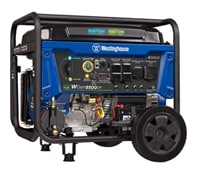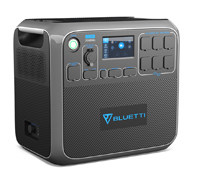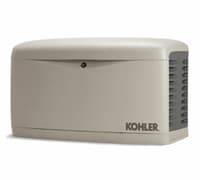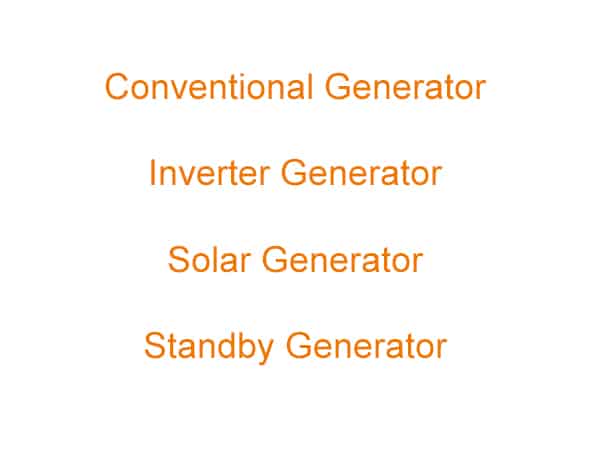Here’s all the info I gathered while trying to buy a new generator. And that’s all you are going to need to know about generators to choose wisely.
There are four types of generators for recreational and residential emergency backup use. Three types are portable (Portable Inverter Generators, Conventional Portable Generators, & Solar Power Generators), and the fourth (Standby Generators) is permanently installed.
1. Portable Inverter Generators

Portable Inverter Generators are sometimes referred to as Closed Frame Generators and are commonly referred to as “Inverter Generators.” They run on Gasoline or Propane, known as Liquefied Petroleum Gas (LPG).
Portable Inverter Generators provide a ‘clean signal’ and safely power all your electronics such as laptops, cell phones, TVs, and any other sensitive equipment. Additionally, inverter generators are very energy efficient as they throttle the engine according to the power drawn by your appliances.
2. Conventional Portable Generators

Conventional Portable Generators, also known as Open Frame Generators, are commonly and casually referred to as “Generators.” Those are typically much noisier and run on Gasoline, Propane (LPG), Natural Gas (NG), or Diesel.
Conventional generators are more suited for large loads such as motors, drills, air conditioning, heating, and refrigerators. However, conventional generators are not very efficient as their engine runs at full speed at all times which depletes your fuel tank much faster.
3. Solar Power Generators

Solar Power Generators, also known as “Portable Power Stations.” These are not exactly generators per se as they have no engine and zero moving parts. A solar power generator will produce zero noise and zero exhaust as they are simply a battery unit that gets charged from either a solar panel or your wall outlet.
Click here to learn more about the difference between batteries and generators.
4. Standby Generators

Standby Generators are not portable and are directly connected to your house. A Standby generator can run on Propane, Natural Gas, or Diesel. Standby generators automatically kick in during a power outage to cover all your power needs and turn back off when power is restored to the main grid. Standby generators are big engines that consume too much fuel for their output.
Here is a quick comparison table of generator types before we delve any deeper into the details:
| Generator Type | Fuel | Noise | Efficiency | Portability |
| Inverter Generator | Gasoline or Propane | Low | Very High | Portable and lightweight |
| Conventional Generators | Gasoline, Propane, Natural Gas, or Diesel | High | Low | Portable but can be a little heavy |
| Portable Power Stations | Solar Panels or Wall Outlet | None | High | Portable and compact, but can be a little heavy |
| Standby Generators | Propane, Natural Gas, or Diesel | Medium | Low | Not portable |
9 Things to consider when thinking about buying a generator
Coming soon: click here if you live in California
1. What do I intend to use the generator for?
First, you need to ask yourself, do I need a portable generator or a permanent installation for my house?
Second, do I need it to run a few home appliances, lights, charge cell phones, and laptops, or do I need a heavy-duty generator to run my AC, heating, water pump, etc…
An inverter generator is usually the best option if your power needs are basic and require a clean signal (pure sine wave) like sensitive electronics (Computer, Cellphone, TV, etc.).
On the other hand, conventional generators can come in handy to run most of what you’ll need during a power outage. It would be best to consider inverter generators for recreational/light camping needs and conventional generators as a backup for your household needs. Remember that conventional generators can be harmful to sensitive electronics.
I decided to have two generators; a conventional one for my house and a small inverter generator for the electronics.
There are many ways to ‘clean’ the power coming out of conventional generators, but you are never 100% safe, and they end up costing you a few hundred bucks. It is always better to have 2 power sources instead of one during a crisis.
Alternatively, you can buy an inverter generator that covers all your needs with a high output power of 5,000 Watts and above, but that will cost you quite a bit.
2. Where will I operate and store my generator?
Whether you live in a house or a condo, you can still have portable backup power. Just keep in mind that you are usually only allowed to have a Portable Power Station if you live in a condo/apartment without an outdoor area.
Click here to learn more about using Potable Power Stations if you have no outdoor areas.
3. How much power do I need from my generator?
Max Starting Watts & Running Watts: Any appliance or tool with a motor will require a higher starting/peak wattage than its regular running/continuous wattage.
The starting wattage is the surge needed to give the appliance its first push. All generators have both specifications written on them, but one should ensure that the total surge watts of all the appliances, equipment, and tools that are together plugged in a generator does not surpass the generators’ specs of Max Starting Watts.
Now, I can provide you with an endless list of home appliances with their starting and running watts, but that is a sure way to purchase the wrong generator size and overload it.
To calculate the number of watts you need, you should physically look at every appliance you intend to use during a power outage and add all their consumption to come up with the correct number. Any appliance, tool, or piece of equipment will ALWAYS have its power consumption written somewhere on its side, back, or bottom. Please be sure to read those and add them up.
Alternatively, I used a small device called Kill A Watt Electricity Usage Monitor (link to amazon) that tells you precisely how much each appliance is consuming over time. This way, I can adequately size my generator and, more importantly, double-check my electricity meter to ensure I’m not paying more than I’m supposed to.
A final thought for generator size is to add a 20% margin above your wattage needs to leave some wiggle room for any unexpected surges, different usages and to keep your generator happily running at a leisurely pace.
4. What fuel type and tank size should I look for?
All things being equal, you should choose a generator with the largest gasoline tank to maximize your run time before having to shut it off and wait till it cools down for refueling. As for Propane, you won’t have to worry about the tank size as it comes ready in a sealed tank that connects to your generator.
Gasoline and Propane are the two most common fuel types found in generators. Below, I’m providing you with a big picture of those two fuels in a straightforward table.
Gasoline vs. Propane as a fuel of choice for your generator:
| Fuel Characteristic | Gasoline | Propane |
| Availability during a crisis and high demand | Remember those long lines at the gas stations during any crisis. A blackout will render those pumps useless as they need electricity to pump gas. | Think about that and start storing some propane, my friend! |
| Handling & Odors | Strong odor and messy handling due to possible spills | Self-contained. Easy storage, no spills, odors, or fumes |
| Shelf life | A couple of months and needs a stabilizer to go for longer | At least 10 years |
| Power Output | Your generator will run as specified | Your generator will run as specified if it is originally designed to run on propane, i.e., not using a conversion kit |
| Run time | It will depend on the generator’s tank size | It will depend on the propane tank size (propane wins!) |
| Cost | Gas will always be cheaper no matter where you are. | The question is how much cheaper, and that depends on where you live! |
| Weather | Ready for use at any temperature | Contrary to popular belief, ready for use at any temperature and less likely to get a stuck engine |
| Environment | Dirty burn | Clean burn |
| Maintenance | Frequent maintenance needed to clean carbon deposits | Little maintenance required thanks to a clean burn |
5. Do I need it to have an alternative fuel capacity?
As the comparison table seems to favor propane, remember that gasoline can come in very handy for recreational use as it is always readily available everywhere. This should remind you to think of the main purpose of your generator.
For an all-purpose generator, I would highly advise you to buy a dual fuel generator if you can afford the higher price tag.
6. Will I use it for long blackouts?
Long blackouts will result in long-running hours for your generator. Having a generator with a fuel gauge can be very handy in such situations.
7. How much will my generator weigh and is it easy to transport?
The average weight of a generator is 180 lbs (82 kg). Generators for residential backup power weigh between 160 lbs (73 kg) to 210 lbs (95 kg) in dry weight. Starting at just 40 lbs (18 kg), you can find the 2000Watt Champion inverter generator up to the 10000Watt Honda EB10000 weighing in at 403 lbs (183 kg).
Always make sure to buy a generator with a set of wheels as they are not always included.
8. How much noise will my generator make?
An inverter generator will produce noise anywhere from 50 dB (the sound of a conversation at home) and 70 dB (vacuum cleaner). A conventional portable generator will produce noise anywhere from 80 dB (garbage disposal) and 100 dB (lawnmower). These sound measurements are made according to the industry standard of being 23 feet away and facing the front of the generator.
The decibels comparison, as mentioned above, are from Purdue University.
In any case, you should always be aware of your local residential laws or campground rules on permissible noise levels.
9. How much should I pay for a generator and when should I buy one?
You’ll notice that I left the cost of a generator at the very end. A generator is a worthy investment that will serve you well for many years in many situations.
To power most of your household needs during a power outage, you will need an all-purpose good portable generator which will cost you around $950.
Of course, it would require a whole article by itself just to provide average prices for portable inverter generators, conventional generators, power stations, and stand-by generators.
But, since most people are looking for conventional portable generators for the occasional outage, below is a table with their average prices.
Price ranges for Portable Generators
| Generator Power Output in Running Watts | Price Range |
| Up to 2000 Watts | $200 – $1,300 |
| 2000 to 4000 Watts | $300 – $2,800 |
| 4000 to 6000 Watts | $350 – $4,600 |
| 6000 to 8000 Watts | $550 – $3,200 |
| 8000 to 10000 Watts | $650 – $4,000 |
| 10000 Watts & above | $1,200 – $5,000 |
You must’ve noticed the significant discrepancy in the price ranges, mainly due to the presence of both very cheap and cheaply manufactured generators and top-of-the-line ones.
Also, some high manufacturers don’t manufacture generators in specific power output ranges.
A cheap generator that breaks down during a power outage or a hurricane is of no use. Saving those extra few hundred dollars means that you have actually spent a few hundred bucks on something that is not working properly when direly needed.
Remember that you can buy generators at exceptionally discounted prices after the end of severe weather events such as the hurricane season when dealers are looking to get rid of any unsold stock.
See how to perfectly time your generator purchase.
9 Technical options to know when buying a generator
1. Electric Start
Generators are traditionally known to be started with a recoil cord. However, electric starters have recently become a common option. And even more recently, wireless remote start and shut off to stay in the comfort of your home during a storm! An electric start will make starting your generator easy with a simple press of a button.
Yet this comes with an extra cost and weight, as your generator will now include a battery to run the electric starter. Having an electric start will also require that you keep the generator’s battery on a trickle charger if you do not intend on pulling that recoil cord after storing it for a long time.
2. Power Outlets
A generator will typically have two 120V outlets (5-15R, 5-20R, 5-30R, or L5-30R), sometimes an additional 120/240v outlet (L14-30R or 14-50R), RV ready outlets TT-30R (TT meaning Travel Trailer) & even a Marine outlet SS2-50 (SS meaning Ship-to-Shore). In inverter models, there should be a USB outlet for your electronics.
As you go for larger units, make sure you have enough outlets that suit your needs.
The NEMA (National Electrical Manufacturers Association) uses 4 identifiers for plugs and receptacles in North America. If we take NEMA L5-30R as an example, the 1st identifier can be an “L” meaning that this is an electric outlet for Locking Devices or a blank space meaning for Straight Blade Devices. The 2nd identifier “5” means 125Volts max and a “14” would mean 250Volts max. The 3rd identifier “30” stands for 30 Amps. The 4th identifier is either “R” for Receptacle or “P” for Plug.
120V outlets: These could be NEMA 5-15R 120V AC 15A, NEMA 5-20R 120V AC 20A or NEMA 5-30R 120V AC 30A
120V AC 30A Locking Plug Outlet: NEMA L5-30R
120/240V AC 30A NEMA L14-30R Locking Plug Outlet
120/240V AC 50A NEMA 14-50R Outlet
RV ready outlet: NEMA TT-30R (TT meaning Travel Trailer)
Marine applications outlet: NEMA SS2-50 (SS meaning Ship-to-Shore)
3. 120V / 240V Selector Switch
If you’re planning on buying a generator larger than 3000 Watts, connecting it to your circuit breaker in your house, or using power tools, you should make sure to have a generator that supplies 240v.
4. GFCI Protected Outlets
GFCI (Ground-Fault Interrupter Switch), also shortened to GFI, is essential for your safety. If you ever come in contact with a faulty appliance or your generator gets wet, you can get electrocuted. Electric shock and electrocution happen when the current (amperage) goes through you rather than going in a loopback to the generator’s circuit.
How a GFCI outlet works:
Normal current flow creates opposing magnetic fields that cancel each other out. When current is leaked through you instead of going back to its source, it creates a discrepancy in the magnetic field, which causes the GFCI outlet to shut off in as little as 0.025 of a second to avoid injury or death.
5. Paralleling Capability
If you would like in the future to double or even triple your total power, paralleling capability comes in handy. Many generators have the option to be interconnected (usually the same brand) to give you more wattage for your home or RV. It is also sometimes useful to have 2 generators of the same type to parallel instead of buying one large generator. Think of it as the ability to break a bill!
6. Low Oil Shutoff Sensor
This option comes in handy if you intend on running your generator unattended for long periods of time. Newer models have a sensor that will shut off your generator in case of low oil to avoid damage to the engine. However, low oil sensors tend to cause many headaches, so if you consistently check your oil levels, it would be counterproductive to look for a generator with this option.
7. Carbon Monoxide Shutoff
As we’ve all heard of countless cases of death by carbon monoxide from generators, I think this one is straightforward. Carbon monoxide is an odorless, colorless, tasteless, and highly toxic gas that kills almost immediately as we don’t feel it creeping up on us. So, either get a generator with a carbon monoxide shutoff or make sure to install detectors around your house and especially in sleeping areas (all while making sure that your generator is 20 feet away from your home).
8. THD (Total Harmonic Distortion) Ratio
The lower the THD, the better. High THD levels may cause sensitive equipment to malfunction, reduce its lifespan or cause damage beyond repair. Generators with THD 5% or less are best suited for your sensitive equipment (computer, tv, etc.). For household appliances and power tools, you can go up to a THD of 15%.
While there is no national standard for THD levels, The Institute of Electrical and Electronics Engineers (IEEE) provides suggested harmonic values for power systems. “Computers, . . . programmable controllers, . . . require ac sources that have no more than 5% harmonic voltage distortion factor (THD), with the largest single harmonic being no more than 3% of the fundamental voltage”; found in IEEE Std 519 titled Recommended Practices And Requirements For Harmonic Control In Electrical Power Systems.
Further reading: unlv.edu, ieee.org, allaboutcircuits.com, usp.br
9. CARB/EPA III Compliance
The Environmental Protection Agency (EPA) issues standards for emissions control. All generators manufactured in the United States should be compliant with the EPA III regulation. In addition, the California Air Resources Board (CARB) enacts its own stricter regulations for the State of California.
Note that many other states enforce the CARB Compliance. If you intend to buy and operate a generator in the State of California, make sure it is CARB Compliant. In general, buying a generator with both compliances will ensure a cleaner burn for your fuel and the ability to freely travel with your generator to any campground in the US.
There you have it!
Any more nagging questions? More topics on generators right here.
